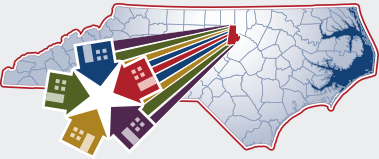Renaming of Oldham Towers
In June of 2019, the Chair of Durham Housing Authority (DHA) Board of Commissioners appointed a subcommittee to review the renaming of Oldham Towers which was named for Carvie Oldham, the Executive Director of Durham Housing Authority in the 50's and 60's.
Commissioner Ray Eurquhart was named chair of the subcommittee. Unfortunately, "Brother Ray" died without being able to complete this work. The subcommittee has continued its work since Brother Ray's passing. Based on their research, the subcommittee presented the following report to the Board of Commissioners at its June 24, 2020 meeting:
Last year, Durham Housing Authority celebrated its 70th anniversary as an Authority. There have been many great accomplishments in our 70-year history. However, there are also some actions that we are not proud of. We should remember this history so that we do not repeat it.
In 1965 during the Oldham administration, Joyce Thorp was evicted for organizing tenants in McDougald Terrace. Oldham argued that he had the absolute right to terminate the lease of a tenant without cause. This case went all the way to the US Supreme Court. The outcome of the case was that housing authorities can only terminate a tenant's lease for good cause. Joyce Thorp, later Joyce Nichols, joined the DHA Board and became Chair in 1995.
During his tenure, Oldham was closely aligned with the white power structure in Durham. Like many southern towns, Durham tried to segregate the African American community in one part of the city. It was customary for the dividing line to be along a railroad, major highway, or other natural barrier.
Consistent with this plan, Oldham's administration began the construction of the Fayetteville Street development in the mid-60's to the south of the 147 corridor and to the east of the abandoned railroad line. The location of the Fayetteville Street development was contested by the activist community because it further segregated African Americans in the southeastern quadrant of the City. However, they were unsuccessful in stopping the development.
Then in 1967, Oldham tried to construct another development in the southeast quadrant of the City on Bacon Street very near McDougald Terrace. This time the community was prepared. Led by Howard Fuller, Ann Atwater and Ben Ruffin, the tenants marched on City Hall and demanded to be heard. Ben Ruffin speaking at the meeting proclaimed:
"Urban Renewal has provided us with a one-way ticket to the ghetto in the southeastern part of the City. We do not want any more projects in this area." Subsequently, the project was not approved by the City Council because of fear of unrest and conflict. However, the damage was already done by Oldham and even today the population in the census tracts of the southeastern quadrant of the City is 98% minority.
The Bacon Street victory was important for the housing authority tenants and their allies. As Mickey Michaux pointed out in an oral history interview, he and Floyd McKissick used this as an opportunity to train public housing residents to oppose what Michaux referred to as the practices on the plantation run by Carvie Oldham.
This work by Michaux and McKissick paid off when in 1968 tenants piled into buses and road through the night to meet with HUD officials in Atlanta. They presented their grievances against Oldham and demanded an investigation. Subsequently HUD determined that Oldham not only failed to support but had hindered the work of the Department of Community Relations lead by Charles Tillman.
Tillman held the job of leading what is now Resident Services. He successfully organized the first in the nation Tenant Neighborhood Corporation at Damar Court. He was a strong advocate for tenant's rights and for providing residents a way to improve their lives and the lives of their children.
Oldham accused Tillman of writing the HUD report. An in 1971, Oldham fired Charles Tillman. At a meeting of protesters at Oldham Towers, Ben Ruffin argued that Tillman was fired so DHA could do away with the Resident Services program.
Finally, in June of 1972, J. J. Henderson was elected chair of DHA. The first order of business was to pass a resolution giving the Board the authority to hire and fire employees making more than $10,000 a year. Immediately thereafter in our own Friday-night massacre, Carvie Oldham and five (5) of his lieutenants resigned.
An editorial appearing in the Carolina Times summarized the Oldham tenure at DHA: "It is no secret that for too long the Durham Housing Authority has been dominated by brick-and-mortar machinery rather than effecting a viable vehicle responsive to the needs of the people they are designed to serve."
Based on the report of this subcommittee, the Board of Commissioners approved a resolution and voted unanimously that Oldham Towers shall no longer be named and known as such. The building will be known by its street address, "519 E. Main Street" until such time as the Board of Commissioners renames the development. It was also stated that the name "Oldham Towers" will be removed from the building as soon as possible.
The Board of Commissioners would like to thank Mr. Eddie Davis, Durham's Public Historian, for his input in this project.


